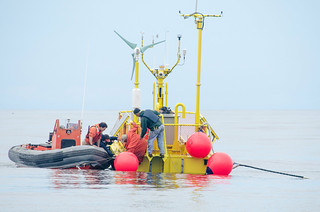The new Oregon Marine Debris Team is looking for hundreds of coastal volunteers to keep an eye out for debris from the 2011 Japanese earthquake and tsunami – and to help clean it up.
The team, a partnership of Oregon Sea Grant and four nonprofit groups – CoastWatch, Surfrider Foundation, SOLVE and Washed Ashore – is leading citizen-based efforts to systematically track and clean up tsunami debris that washes up on the Oregon Coast. Volunteers will be asked to systematically monitor, identify and report areas where tsunami debris accumulates, and to participate in cleanup efforts.
Interested coastal residents and visitors can sign up by subscribing to the team’s marine debris notification list and indicate their volunteer interests and geographic areas.
Public agencies, led by Oregon State Parks, have set up debris reporting hotlines, provided receptacles and will collect material too dangerous or bulky for volunteers to handle. The federal government, through the National Oceanic and Atmospheric Administration, announced Monday that it would provide $250,000 to the five western states likely to be affected by the tsunami debris (Alaska, Washington, Oregon, California and Hawaii). However, at $50,000 per state, the grants are expected to cover only a small fraction of cleaning up however much of the estimated 1.5 million tons of debris drifting across the Pacific winds up on US coasts.
The debris was washed from the Japanese shore by the tsunami that followed the devastating earthquake that hit northern Japan on March 5, 2011, killing thousands and sweeping away an estimated 5 million tons of buildings, fishing vessels and personal belongings. Much of that sank off the Japanese coast – but buoyant items, from fragments of plastic and paper to stray boats and cargo containers, have been floating the Pacific currents ever since, and are beginning to show up on US coastlines.
The budget-strapped West Coast states lack the resources to clean up everything that arrives.The cost of removing the single largest piece of tsunami debris to hit Oregon to date – a large dock that washed ashore last month at Agate Beach on the central Coast – will run just over $84,000, according to Oregon Parks & Recreation, which has hired a contractor to remove and dispose of the dock starting July 30. A small piece will be kept as a memorial to the tsunami victims.
“Cleaning up our beaches relies upon all of us,” said Charlie Plybon, , Surfrider Foundation Oregon Field Manager. “The key to responding to this challenge … lies with educating and activating volunteers.”
The Oregon Marine Debris Team is hoping to recruit enough volunteers to monitor every beach, cove and headland for debris, and to be on call for cleanup alerts in given areas. “Agencies are not able to do that,” Plybon said. “It is up to us, the people who care for our coastline and take responsibility for it, to step up. Our role as nonprofits is to provide the support to make that happen.”







